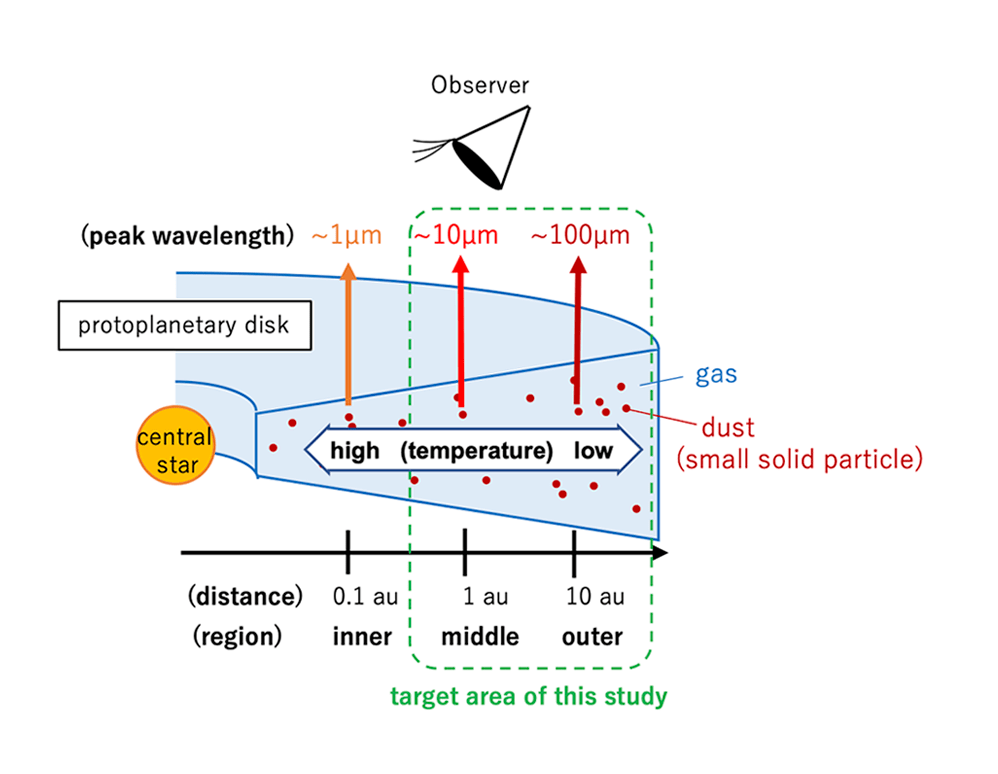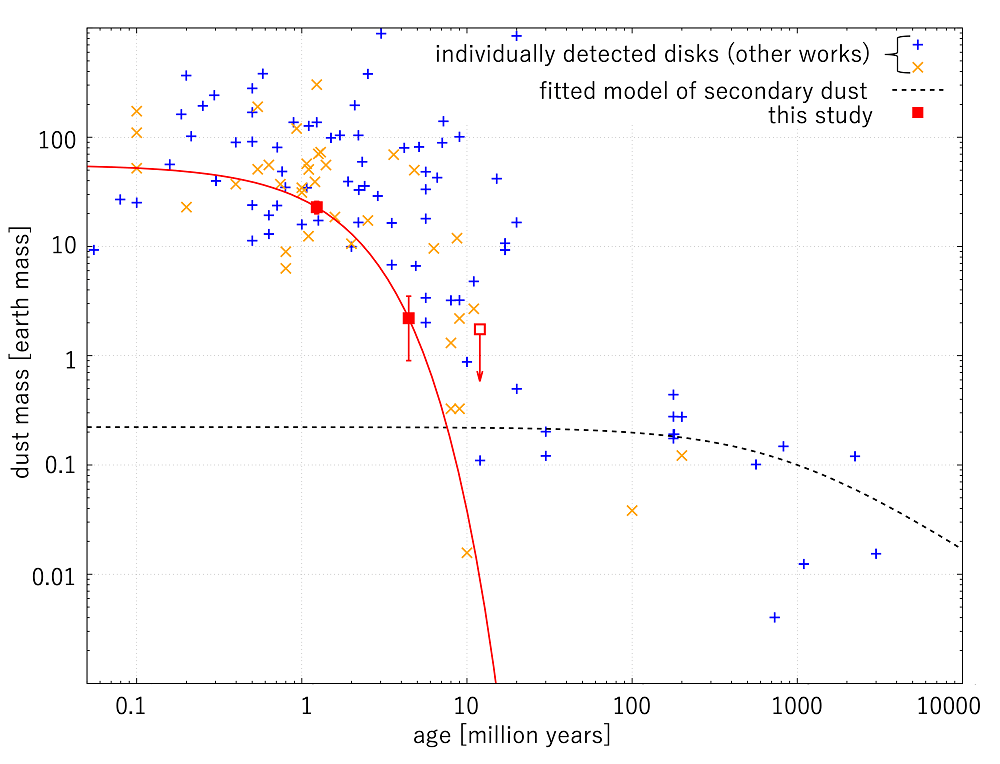Dissipation timescale of dust in protoplanetary disks revealed with Japanese satellite AKARI
Dec. 15, 2021 | GATEWAY to Academic Articles
Protoplanetary disks are circumstellar disks that surround young stars. The disks consist of dust and gas, which are the raw materials for creating planetary systems. Thus, the dissipation timescale for the disks is essential to study planet formation. However, the timescale for the outer region of these disks (about 10 au from the central star, where 1 au is the average distance between the Earth and Sun) has not been revealed observationally due to the relatively low sensitivity of detectors. From all-sky data from the Japanese infrared astronomical satellite AKARI, and NASA’s Wide-field Infrared Survey Explorer (WISE), we obtained a number of infrared images of young stars previously detected at optical wavelengths. We estimate the decay timescale of the infrared radiation emitted from the dust in the disks surrounding these stars by making averaged infrared images, including those for stars that could not be resolved individually.
Our result shows that the dust in the disk middle regions (about 1 au) and the outer regions (approximately 10 au) dissipates on almost the same timescales, contrary to the expectation of inside-out disk clearing, where the middle region would dissipate first. Moreover, we reveal that the dominant dust changes from primordial dust, which has existed since the disk formation, to secondary dust, which is formed by collisional destruction of small planets (planetesimals) in the disks on the timescales of about 8 million years.
Research Summary
Protoplanetary disks are circumstellar disks that surround young stars. The disk consists of gas and dust*1, which are the raw materials of planetary systems. Because the gas and dust in disks dissipate with the evolution of the central star, the study of the dissipation process in each disk region is essential for understanding how planet formation occurs; a process that must be mainly complete before dissipation of the disk. Although previous studies discuss the dissipation timescale in the inner-middle region (less than about 1 au*2 from the central star), the timescale in the outer region (about 10 au) has not been researched due to the relatively low sensitivity of detectors that make this region difficult to see. Also, it is known that the dominant dust type must change from primordial dust, which has existed since the disk formation, to secondary dust, which is formed through collisional destruction of small planets (planetesimals) as the disk evolves. However, the timescale for this change has also been unclear.

To reveal the average dissipation timescale, we need statistical sample of many disks. Currently, spatially resolved observations of dust disks is usually performed at sub-mm or mm wavelengths, but the observations of many disks are not practical because of the vast amounts of time required. On the other hand, the dust farther from the central star is cooler and emits infrared radiation with at a longer-wavelength peak (Fig. 1). Therefore, observations at several wavelengths in the infrared give information on the spatial distribution of dust at these distances. In this study, we obtain a number of infrared images of young stars from the all-sky images captured by the Japanese infrared astronomical satellite AKARI*3 and by the Wide-Infrared Survey Explorer (WISE)*4. However, evolved disks are difficult to detect due to their weak infrared emission. Therefore, we classified young stars into three groups according to their age and averaged the infrared images of the young stars, including images where the star itself cannot be directly seen, in the same age group. Because random noise can be reduced by the averaging process, we can obtain a more sensitive average infrared image than through imaging these systems individually. From the averaged images of three age groups, we estimated the decay timescales of the infrared intensities.
This study revealed two results:
(1) Dust in the middle and outer regions of the disks dissipates on almost the same timescale, about 1.4 million years, and there is no timescale difference in this region. The dust disks are traditionally considered to dissipate from inside to outside, but our result is contrary to this expectation. This discovery was possible because our study was able to give a quantitive timescale for the outer disk region.
(2) The dominant dust changes from primordial dust to secondary dust on the timescale of about 8 million years (Fig. 2). Revealing the transition of the dust sources is expected to lead to the clarification of the disk evolution.

This study reveals the dissipation timescales of dust in disks quantitatively. However, what physical process causes the disk dissipation is still under discussion. By revealing the constraint of the dissipation timescale, this result can aid theoretical studies of the disk evolution and planet formation process.
Terminologies
- *1 dust : Small solid particles in space.
- *2 au (astronomical unit) : A unit of length, roughly the distance from the earth to the sun (about 150 million kilometers).
- *3 AKARI : Japanese infrared astronomical satellite launched in 2006. AKARI made all-sky surveys and spectroscopic observations in the infrared wavelength range. In particular, all-sky surveys were performed in six wavelength bands (9, 18, 65, 89, 140, and 160 µm).
- *4 WISE (Wide-field Infrared Survey Explorer) : American infrared astronomical satellite launched in 2009. All-sky surveys were performed in four infrared bands (3.4, 4.3, 12, and 22 µm).
Information
| Journal Title | Publications of the Astronomical Society of Japan |
|---|---|
| Full title of the paper | Dust dissipation timescales in the intermediate and outer regions of protoplanetary disks |
| DOI | https://doi.org/10.1093/pasj/psab095 |
| Publish date | 28 October 2021 |
| Author(s) | Hiroshi Maeshima, Takao Nakagawa, Takuya Kojima, Satoshi Takita, Jungmi Kwon |
| ISAS or JAXA member(s) among author(s) | Hiroshi Maeshima (Dept. of Space Astronomy and Astrophysics, ISAS / Dept. of Physics, Graduate School of Science, The University of Tokyo), Takao Nakagawa (Dept. of Space Astronomy and Astrophysics, ISAS), Takuya Kojima (Dept. of Space Astronomy and Astrophysics, ISAS / Dept. of Physics, Graduate School of Science, The University of Tokyo) |


 MAESHIMA Hiroshi
MAESHIMA Hiroshi